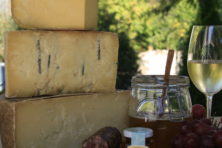The Art of Serving Cheese
- Share
- Tweet
- Pin
- Share

Cheeses can be served in a variety of ways, times, and for different occasions. I will never forget the time my father, brother and I were visiting relatives in Scotland in the late ’70s. My cousin Robin and his wife Winnabelle had us over for dinner one evening, and after we finished a satisfying four-course dinner, they rolled this beautiful cart into the dining room.
My first thought was, “Oh my god, I can’t even think about eating anything else.” When I looked at what was on the cart I saw nothing but a full tray of beautiful cheeses. Robin began to describe each of the cheeses being offered, including Stilton, a cloth-bound cheddar and a bloomy rind soft cheese.
I quickly learned that this was a European tradition, to eat cheese at the end of the meal. In my home we ate cheese, usually cheddar, with Ritz crackers as an appetizer before dinner. Today you will see cheese being served as a dessert course in some of the finest restaurants in America, as well as being on an appetizer course. Cheese can even be a main course, accompanied by lightly dressed salad greens and seasonal fruit.
Many times people will ask our cheesemongers (people that work behind our cheese cases  at Schoolhouse Artisan Cheese in Egg Harbor) what they should serve as a cheese plate for a social gathering. How many cheeses, how much of each cheese, and what type of cheese to offer? There are some basic rules that one should consider when serving a cheese plate, although it is really up to the tastes of the host.
at Schoolhouse Artisan Cheese in Egg Harbor) what they should serve as a cheese plate for a social gathering. How many cheeses, how much of each cheese, and what type of cheese to offer? There are some basic rules that one should consider when serving a cheese plate, although it is really up to the tastes of the host.
Flavor and texture matters: a well-rounded cheese plate could include a farmstead cheddar, a medium-aged gouda, a fruity well-aged emmental (Swiss), a fresh chèvre (soft goat cheese), and a rich, creamy blue cheese. I prefer having the cheese in a wedge or large piece so that people can cut their own size, versus having the cheese sliced on the plate.
It should also be noted: I feel you’re better off serving two or three exquisite cheeses on a cheese plate than serving four to six mediocre cheeses. You want your guests to enjoy every cheese on the plate, not just some of them.
The cheese being offered on a cheese plate should be served at room temperature, which means it should be left outside a refrigerator at least an hour before serving, preferably covered with a cheese dome, or plastic wrap to prevent the cheese from drying out.
When putting together a cheese plate we often are asked how much of each of the cheeses should be served to your guests. If it is more than two to three cheeses we recommend approximately 1.5 ounces of each cheese per guest. If your cheese plate has one or two cheeses it is best to figure 2 ounces per guest. None of those rules are etched in stone, but rather a guide for the host.
Enjoy serving the fantastic artisan cheeses being produced here in Wisconsin with friends and family, they will be glad you asked them to join you.
Photography by Len Villano.



